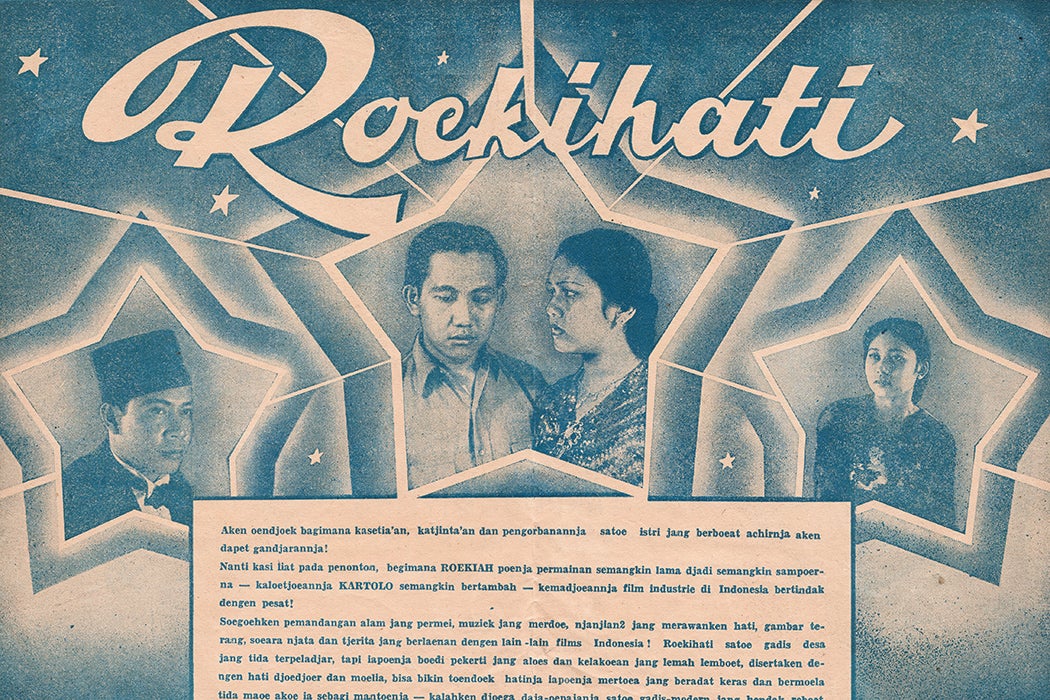Cinephiles may know the 1950s and 1960s as the golden age of Malay movies—the heyday of stars like P. Ramlee and Maria Menado and studios like Shaw and Cathay-Keris. But Malay-language cinema in fact started as early as 1940 and 1941, when—heralding the more than 250 movies to come in the next decades—at least eight films were made in Singapore. Sadly, “[a]ll of these pre-war films have been lost, mainly due to the use of nitrate film, which easily deteriorates even under the best conditions,” reports historian Timothy P. Barnard.
Turning to the next best source, Barnard has recovered this lost history through the five surviving issues of the magazine Film Melayu, which was published between May and December 1941. The abrupt growth of Malay-language cinema in Singapore and the Dutch East Indies (present-day Indonesia) “raises issues and questions over the meaning of Malay national identity and its relationship to publishing and technology in the immediate period prior to World War Two,” he writes.
Film Melayu was supported by the Chinese Shaw Brothers movie house—although editor Haji Abdullah bin Ja’afar professed editorial independence from investors—and published by Utusan Melayu Press, which Barnard describes as “ethno-nationalist” but, in principle, “not exclusivist.” From the get-go, Film Melayu, with its focus on the medium of film, asserted a modern outlook. Haji Abdullah, who also went by the pen name Haaj, chose to publish the magazine in the romanized Rumi (Roman) script, rather than Arabic-based Jawi.
“This was quite a radical departure for the Malay community as few if any Rumi newspapers or magazines had met with success in the Malay Peninsula by the late 1930s, and there had been no successful film magazines,” observes Barnard.
However, Haji Abdullah believed that Rumi would make Film Melayu accessible to local readers “regardless of ethnicity,” enabling the collective artistic development of film and music. The magazine also explained in its first issue that using Rumi widened its readership to the colonial Dutch East Indies where the writing system was preferred. Barnard argues that this publishing choice reflects a “shift in the notion of bangsa [community] beyond an ethnocentric Malay ‘race’ to one advocating inclusion of the wider archipelagic community.”
On the other hand, there was also occasional pushback from contributors uncomfortable with the role of Javanese actors or non-Malay-speaking Chinese directors in Malay-language film.
“As more films produced in Malay but starring non-Malays were shown in cinemas in Singapore and Malaya, their presence began to reflect limits to how Malayness was understood,” notes Barnard.
Weighing in with letters to the editor, Film Melayu readers also engaged in ongoing debates about the potential cultural and political implications of modern film technology and storytelling. For instance, one supported an editor’s call for stage-trained actors to eliminate “unnatural mannerisms,” originally from the traditional bangsawan opera style, from the silver screen. Another letter-writer suggested that storylines, which sometimes emphasized marriage and tragedy, promote values that could “improve the conditions of our society with refined feelings.”
Barnard explains that pre-war movie plots “were quite similar, with a particular focus on the frailty of marriage,” which he connects to modern concerns about urban migration and capitalism.
Weekly Newsletter
Not just a chronicle of hot political topics, Film Melayu remains a vital resource for Malay cinema of this era as well, since these films now all exist only as “scattered still photographs and references to them in Film Melayu and newspapers in which the plots are rarely explained.” Barnard points out, however, that advertisements did contain “extended explanations of the plot, most likely to prepare the audience for inaudible sound and poor production” at screenings.
“From these available texts,” Barnard writes of the Film Melayu archives, “much can be learned about not only film and its development in Singapore but also Malay culture and politics in late pre-war Malaya and how they reflected various debates in the publishing industry.”







